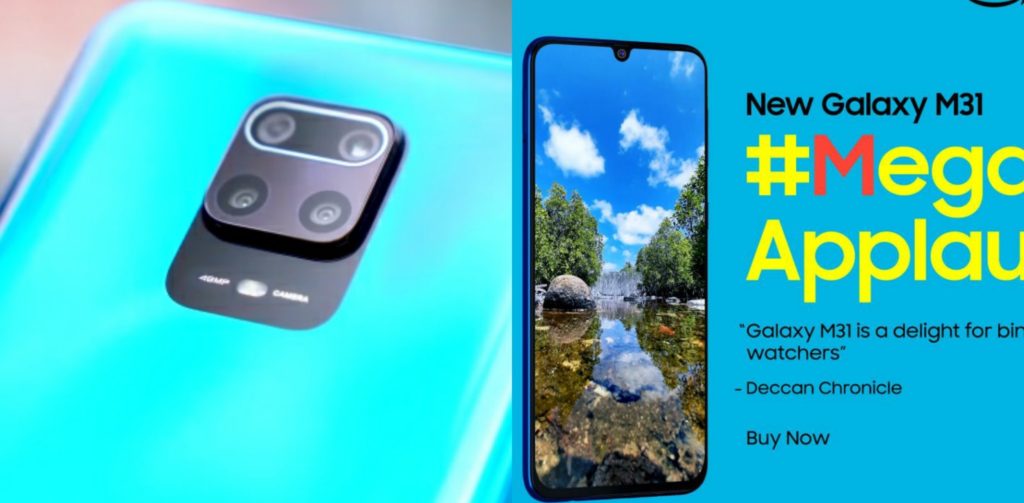Redmi Note 9 Pro vs Galaxy M31: 48MP vs 64MP, Does Samsung Win Here?
Can Galaxy M31 beat Redmi Note 9 Pro? Does 64MP triumphs the new 48MP camera? The new budget mid-rangers by Xiaomi and Samsung offer a ton of features packed by mid-range chips, big batteries, larger displays and top-end cameras.

Galaxy M31 has a 64-megapixel quad rear camera setup with a 32-megapixel selfie camera.
On the other hand, the new Redmi Note 9 Pro packs in a 120Hz display on a budget, all new gaming-centric Snapdragon 720G, new 48MP Samsung GM2 quad cameras, big battery and more.
Here’s a quick comparison of the specs and features offered by Galaxy M31 and Redmi Note 9 Pro.
Contents [hide]
Display, Build
Redmi Note 9 Pro comes with a new design on the out made out of glass featuring a 6.67-inch IPS LCD display on top offering Full HD+ resolution. It’s a 60Hz display but offers 120Hz touch sampling rate with a punch hole camera at the top centre of the display.
Redmi Note 9 Pro sports a splash proof P2i coating with anti-corrosion layer for the internal components.
Galaxy M31 features a 6.4-inch Full HD+ Super AMOLED Infinity-U display. The Samsung smartphone has an U-shaped notch in the middle of the screen compared to the punch-hole offered by Redmi Note 9 Pro.
Hardware
Redmi Note 9 Pro is powered by Snapdragon 720G, the new mid-range gaming-centric chip by Qualcomm. The chip pairs with 4GB or 6GB of RAM and 64GB or 128GB internal storage.
The device supports a dedicated storage slot and features a side-mounted fingerprint sensor.
Samsung Galaxy M31 runs on the mid-range in-house Exynos 9611 octa-core chipset coupled with 6GB RAM with 64GB or 128GB storage, which can be further expanded to 512GB with the help of an external memory card.
Cameras
Redmi Note 9 Pro will have a new 48MP camera and not the 64-megapixel main camera from the predecessor. The Note 9 Pro will use the new 48-megapixel Samsung GM2 sensor.
The four camera block behind will further pack an 8-megapixel ultra wide-angle camera offering 120-degree field of view, a new 5-megapixel macro sensor with support for 2cm to 10cm focus distance.
Finally Note 9 Pro camera module is supported by a 2-megapixel depth sensor. Upfront, the punch-hole houses a 16-megapixel selfie shooter.
In the Galaxy M31 optics department, we get a combination of a 64MP main sensor. So, it’s a 48MP vs 64MP battle here.
Galaxy M31 quad camera system further includes a 5MP macro sensor, a 5MP depth camera and an 8MP ultra-wide shooter. Upfront, Galaxy M31 has a 32MP selfie snapper. Samsung is offering a dedicated Night Mode capable of 4K video recording, both front and back cameras.
Software
Redmi Note 9 Pro runs on the latest MIUI 11 based on Android 10. Both Realme 6 and Redmi Note 9 Pro comes with support for NavIC by ISRO, which uses Indian satellites for navigation.
Galaxy M31 also comes with Android 10 with new OneUI skin 2.0 on top.
Battery, Fast Charging
Redmi Note 9 Pro packs a massive 5,020mAh battery this time supporting 18W fast charging. In comparison, Galaxy M31 has a mammoth 6,000mAh battery. The Samsung phones wins it clean here, where Galaxy M32 can easily last for two days of usage.
The company claims that M31 can run for 21 hours for internet (Wi-Fi, standard) and up to 48 hours for calls, up to 26 hours for video playback, and up to 119 hours for music playback.
Galaxy M31 ships with a 15W fast charger in the box.
Pricing, Availability
Redmi Note 9 Pro price starts at Rs 12,999. The device has been launched in two different storage variants. The base model is available with 4GB RAM and 64GB storage, priced at Rs 12,999. The top-end variant comes with 6GB RAM and 128GB, is available for Rs 15,999.
Redmi Note 9 Pro will be available via Amazon India and Mi.com starting March 17, 2020. It will be available in three different color combinations: Interstellar Black, Glacier White and Aurora Blue.
Samsung Galaxy M31 price in India starts at Rs 15,999 for the 64GB model. The top-end 128GB storage model is priced at Rs 16,999. Both the Samsung Galaxy M31 models will come in two colour options: Ocean Blue and Space Black.

Comments are closed, but trackbacks and pingbacks are open.